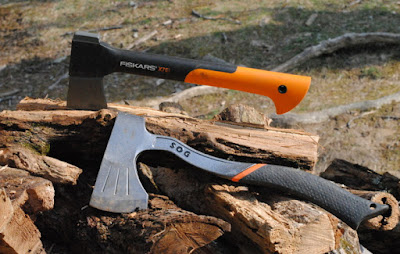I recently spent an extended weekend
in a cabin in southern West Virginia. It
is beautiful country filled with rugged trails and incredible views. The cabin had a brick lined fireplace and a
wood pile was available, so I made use of it.
In anticipation of chilly nights
and warm fires I packed my SOG hatchet.
It didn’t work very well. Despite
the small amount of cutting I did several years ago, my hatchet was dull. Using that axe really brought out the true
meaning of the expression, “Firewood warms you twice. Once when you cut it and again when you burn
it.”
Fortunately my nephew brought his
hatchet, a smaller and much sharper Gerber.
It didn’t take too much work before I realized that my SOG made fast
work of splitting quarter logs in to eighths, but was crappy for making the
thin pencil-like sticks need to build fires.
The Geber made nice pencils of wood but failed to impress the larger
quarter logs.
 |
| The Gerber is noticeable lighter and compact than the SOG |
The two hatchets would complement
each other (after I re-sharpened the SOG), but you really can’t completely
interchange them.
The Gerber has a small head
resembling a flat grind Regular Wisconsin while the SOG has what appears to be
a modified double bevel Virginia.
 |
| Gerber hatchet head |
Don’t
be confused, think of grind the same way as you think of knife grinds. Axe head style defines the shape and
appearance of the axe head. Historically,
some heads worked better than others for specific jobs. What worked for splitting long logs into
quarters or fence rails, wasn’t the best design for log bucking. Some axe heads just develop a regional
interest and became known by that name.
 |
| SOG hatchet head |
My cutting experience indicated
the Gerber might be a great hatchet for backpacking. It weighs in at 22.4 ounces and is 14 inches
long. Not a bad combination for carrying
in a pack. The small size limits its
practical use. Need to cut a tent pole
or cut down branches into small burnable size?
Great! Quarter a four inch
diameter log, not so hot. Typically,
after you drive the hatchet into wood, you would pull the handle to one side or
the other to rotate the metal head to act as an expanding wedge. This action causes the crack to propagate
down the wood. The short handle made it
feel like I couldn’t produce enough torque to turn the axe head and the split
wood. The handle is a fiberglass
composite and I felt queasy about using it as a lever arm.
My dull SOG weighs in at 33
ounces and is 16 inches long. The steel
is a 1055 steel. It is too heavy for very
much backpacking. Car camping, sure
bring it along, but why not bring a three quarters length axe and really chop
wood?
The SOG’s weight and steel handle
gave me confidence I wasn’t going to break anything but the log when I twisted
the hatchet handle to pry wood apart.
The dullness made it difficult to cleanly split the wood into pencil
size kindling.
The SOG camp axe has a RC hardness
of 50-55. Not bad for a hatchet, but I
noticed that after several days of chopping wood the edge had several
dents. Clearly a sharpening stone or
file should be this hatchet’s constant companion.
 |
| Pick the right tool for the right job! |
All I could find on the Gerber
was that it has been replaced by a new and improved version. The hardness wasn’t published. But I wouldn’t be afraid to carry it into the
woods.
So, I learned I need to look
after my hatchet better and that proved what I already knew: the right tool
makes any job easier!